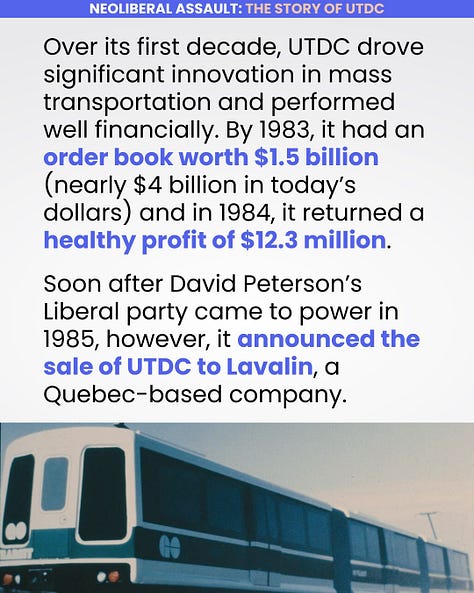Ontario Built a Profitable Train Business (Then Got Rid of It)
Neoliberalism’s assault on the public sector: The UTDC story.
In the early 1970s, the Government of Ontario made a bold move—it established the Urban Transportation Development Corporation (UTDC), a publicly owned enterprise (or Crown corporation) tasked with revolutionizing mass transit. UTDC soon became a leading designer and manufacturer of train systems, responsible for iconic projects such as Toronto’s streetcars, Vancouver’s driverless SkyTrain, Detroit’s People Mover, and San Jose’s light rail system. By 1983, UTDC had an order book worth $1.5 billion (nearly $4 billion in today’s dollars) and returned a healthy $12.3 million profit in 1984.
Despite this success, UTDC was privatized in 1986. What followed was a series of ownership changes, highlighting failures in the logic of neoliberal privatization.
A Conservative Case for Public Ownership
In what would surely be dismissed by today’s conservatives as heresy, UTDC was founded by a conservative government—that of Ontario Premier Bill Davis. Davis rejected the highway expansion mindset of the era and instead prioritized mass transit, famously stating when cancelling Toronto’s proposed Spadina Expressway:
If we are building a transportation system to serve the automobile, the Spadina Expressway would be a good way to start. But if we are building a transportation system to serve people, the Spadina Expressway is a good place to stop.
Davis recognized that mass transit development was too risky and complex for the private sector to handle alone. A government-owned entity was best positioned to research, develop, and implement new transportation technologies and systems.
The Neoliberal Push to Privatize
Despite its success, UTDC became a casualty of the 1980s neoliberal wave, which saw widespread privatizations under Margaret Thatcher in the UK and other western countries. When David Peterson of the Ontario Liberals took office in 1985, his government quickly announced plans to sell UTDC. The reasoning was ideological: In the world of neoliberalism, governments should be small and stay away from business.
But as some media voices pointed out at the time, the sale made little economic sense. A 1985 Toronto Star editorial questioned:
We don't understand the rush to sell UTDC. It is a profitable firm (it made $14 million last year), a major employer in Ontario (accounting, directly or indirectly, for an estimated 6,800 jobs this year), and it has a rosy future (an estimated $10 billion market for transit sales around the world in the next five years). (Toronto Star, 07 Dec 1985, B2)
Another 1986 editorial echoed these concerns:
Before Peterson and cabinet take the final plunge and sell UTDC … they should consider what would be lost. UTDC is a profitable company, a worldwide standard-bearer of Ontario's industrial ability, and a major employer in the province. (Toronto Star, 1 Feb 1986, B2)
Selling UTDC for a Fraction of Its Value
The privatization process itself was counter-productive. Once the Ontario government signaled its intent to sell UTDC, new orders dried up. International customers were hesitant to commit to projects from a supplier with an uncertain future. Since transit systems require years-long (and sometimes decades-long) commitments, buyers needed assurance that UTDC would still be around to honour contracts. Government ownership offered the stability they sought, while privatization introduced the very risk they wanted to avoid.
This uncertainty depressed UTDC’s value, making it a bargain for private buyers. In 1986, Ontario sold UTDC to Lavalin Industries Inc. for just $30 million while assuming millions more in liabilities for projects that were already underway. An Ottawa Citizen editorial criticized the deal:
For a firm [Lavalin] in which taxpayers have invested $167 million since 1974, the province will receive precisely $10 million now and a further $20 million in 10 years. But neither the government nor Lavalin is willing to speculate about how much that might be, or even if profits will materialize at all. (Ottawa Citizen, 18 July 1986, A8)
Private Ownership Fails—Government Steps In Again
Despite acquiring a majority stake in UTDC at a bargain-basement price, Lavalin quickly realized that a private firm could not sustain the business alone. As David Pattenden, president of the privatized UTDC, admitted to the Globe and Mail in 1988, the company “cannot survive in the international marketplace unless we have very, very strong government support." He went on:
What we really want more from the provincial Government than simply a cheque is the Government’s support into the future. Governments always like to see another government involved. (Globe & Mail, 13 Aug 1988, B1)
Which makes sense—as mentioned above, customers for these massive infrastructure projects want the backing of governments to ensure completion. But this begs the question: what was the point of privatizing UTDC if it still needed government backing?
In any case, Lavalin, despite all its generous public support and the sweet deal it received for the train maker, filed for bankruptcy in 1991, forcing Ontario to take back control of UTDC.
A Second Privatization—With More Subsidies
By this time, Ontario was governed by the left-wing NDP under Bob Rae. Yet, even Rae’s government succumbed to neoliberal thinking, choosing to sell UTDC once again—this time to Bombardier in 1992. “There is no alternative,” apparently.
But privatization wasn’t quite “free enterprise”—it required even more taxpayer support. As part of the deal, Ontario paid Bombardier a $17 million subsidy to keep UTDC’s Thunder Bay and Kingston plants open—a condition that could have simply been mandated at no cost had UTDC remained government-owned.
Over the next three decades, Bombardier continued developing and marketing UCTD’s products. But it also continued to rely on government support, including direct grants, loans, and tax incentives. One estimate puts total Canadian government aid to Bombardier’s various units at over $4 billion. Others peg it much higher.
And fast forward: Despite the largesse of government support, in 2021, Bombardier, weighed down by—guess what?—financial struggles, sold its rail division to Alstom, a French multinational. This transferred UTDC’s legacy—developed with public funds—into foreign hands.
Lessons from UTDC’s Story
The UTDC saga highlights the failures of neoliberal privatization. A profitable, innovative public company was sold off, leading to the newly privatized firm demanding continual government support only to eventually turnover the national asset to foreign ownership.
At a time when Canada faces economic uncertainty, rising tariffs, and global supply chain challenges, government ownership of certain industries is more relevant than ever. Public ownership is not just about ideology—it’s a practical tool for safeguarding jobs, innovation, and national economic interests.











